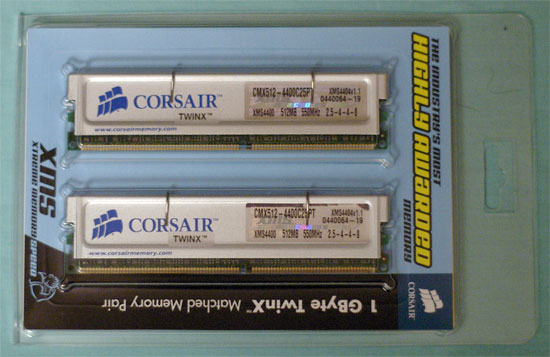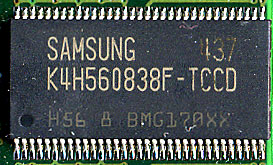Corsair 4400C25: Taking Samsung TCCD to New Heights
by Wesley Fink on January 4, 2005 12:05 AM EST- Posted in
- Memory
Corsair PC4400
Corsair is the most universally-recognized brand of enthusiast memory. However, for quite a while, Corsair had no interest in being included in comparative memory roundups as they referred to themselves as "the BMW of memory providers". There was even a period of time where Corsair refused to provide review samples to websites that did reviews comparing Corsair memory to other brands. Fortunately, the thinking at Corsair has changed in the last few months, and Corsair is again actively sampling websites like AnandTech, which insist that comparisons are the best way to evaluate products. We are really glad that Corsair is active in AnandTech memory reviews again, and we were very excited to see what Corsair had done at the high end with their new DDR550 memory.
As you can see in the photo, the DIMMs are identified as CMX512-4400C25P with an ID of XMS 4404v1.1. Corsair supplies the new DDR550 memory as a matched pair of SS 256MB, called TwinX512-4400C25, and as a matched pair of double-sided 512MB DIMMs, identified as TwinX1024-4400C25. For testing, Corsair supplied a pair of double-sided 512MB DIMMs with aluminum platinum-colored heatspreaders. This 1GB pair is the same configuration tested in other AnandTech reviews of Samsung TCCD memory.

The DIMMs are mounted on a PCB that appears identical to a PCB used on a few other top TCCD DIMMs. The PCB ID is BP MLL E186014, which appears to be the top performing Brainpower PCB used by OCZ, Geil and G. Skill, just to name a few. This PCB has developed quite a reputation for top performance at high speeds with Samsung TCCD, so we expect great high-end results from this Corsair DDR550. Those of you wondering how to identify a Brainpower PCB will be pleased to know that it is distinguishable by just 8 components along the lower edge of the back side of the DIMM - just above the slot fingers. Most other PCBs that we have seen used with TCCD are strewn with components along this edge on both sides. This quick ID method will change with future designs, but if you see DIMM side with just a very few components above the slot, it is likely the brainpower PCB.

With the heatspreader removed, you can also clearly see that the memory chips are definitely Samsung TCCD. As you will see in our review, the behavior curve for this Corsair DDR550 is a bit different than what you have seen in other TCCD reviews. We wanted to make sure that we were indeed dealing with Samsung TCCD and not some new variant of Hynix chips or a special unlabeled bin developed by a chip manufacturer for Corsair.
| Corsair PC4400 Specifications | |
| Number of DIMMs & Banks | 2 DS |
| DIMM Size Total Memory |
512 MB |
| Rated Timings | 2.5-4-4-5 at DDR550 Typically 2-2-2-5 at DDR400 |
| SPD (Auto) Timings | 2.5-4-4-8 |
| Rated Voltage | 2.75V |
With Intel's introduction this summer of the Intel 915/95 chipsets with support for DDR2 memory, the primary market for DDR memory has become the excellent AMD Athlon 64 platform. However, some 915 boards also support DDR, and the continuing Intel Socket 478 also supports DDR memory. For these reasons, Corsair DDR550 was tested on both the standard Intel 478 memory test bed and our newest Athlon 64 Socket 939 test bed.










23 Comments
View All Comments
kmmatney - Tuesday, January 4, 2005 - link
The review did have some mid-range memory in the tests. Their value was noted in the last sentence of the review, but it should be highlighted more.According to the review, the PQI turbo 3200 performed almost as well, but is almost half the price! The money saved can be spent on a cpu or video upgrade.
A quick glance at NewEgg shows PQI turbo 4000 memory priced at $95.50, which I think is a good deal.
PrinceGaz - Tuesday, January 4, 2005 - link
#6- I've been wondering about the value/mid-range round-up too. Looking at the AMD 533/2.4GHz results page, the largest difference between the best and worst memory types in the real-world applications is just over 3%, and these are applications that were chosen because they are more affected by memory-bandwidth than usual. At the end of every review of premium memory it should say "it doesn't really matter which premium module you get for an AMD system so buy the cheapest as it'll make no real difference in performance, and the money would be better spent on a higher-rated CPU or better cooling". Maybe the worry is that if they test some budget/mid-range memory, they'll find you'd be better off getting that instead of the premium modules because it makes so little difference, and that would annoy the companies that send them premium samples :pIntel platforms are more affected by memory bandwidth, but they are moving to DDR2 which makes DDR tests increasingly irrelevant for them.
HardwareD00d - Tuesday, January 4, 2005 - link
Wes - Thank you for the clarification.I'll trade you my 2 sticks of ShikaXRam for your Corsair sample. ;)
Wesley Fink - Tuesday, January 4, 2005 - link
#9 - No conspiracy intended. Our AMD memory test bed was not even set up when we tested the Shikatronics memory in June. We have stated many times that Hynix B, the chipsets used in the Shikatronics, does not generally perform as well on the Athlon 64 platform as it does on Intel. TCCD usually does better on AMD than Intel. Also the timings are 3-4-4 on the Shika which are slower than TCCD at the same memory speed.Just to make sure we weren't blowing smoke, I popped the Shikatronics 550 into the AMD test bed. It did it's specified DDR550 on the A64 at 3-4-4-10 2.85V, which is excellent for Hynix B on AMD. However, I could not make it to even DDR560 as the memory topped out at 554 on the AMD platform.
We are testing new memory on both AMD and Intel, but we have not gone back to past Hynix B dimms for an AMD update, nor do we plan to.
HardwareD00d - Tuesday, January 4, 2005 - link
I've got the Shikatronics PC4400 DC kit for my Athlon64, and I'd like to see that compared against the Corsair modules. It IS on the Intel side, and is the clear winner. Seems strange that you wouldn't compare the "priorly fastest" memory (per a previous review) against the new Corsair modules. This omission seems a little fishy to me.erinlegault - Tuesday, January 4, 2005 - link
Maybe other PC4400 rated memory from other companies should be compared, especially the OCZ PC4200 Pt Series ram. All the ram used was PC3200, except for the PC3700 OCZ, and overclocked from the rated 400MHz to near 600MHz. The Corsair PC4400 memory was only overclocked from the rated 550MHz to 636MHz. I would personally like to see if any other PC4000 or higher rated memory could do any better.Wesley Fink - Tuesday, January 4, 2005 - link
#2 - We used 5X HT at stock speeds, 4X HT for 218 and 240, and 3X HT for 267 up. All other settings are in the reviews.#4 - With the huge number of memories reviewed at AnandTech, we feel comfortable in talking about relative positioning of tested memory. With 28 memories compared in performance on the Intel charts and seven different DDR400 2-2-2 memories in the AMD charts, there is certainly comparative info to draw conclusions. The Corsair 4400C25 proved to reach the highest FSB, but it was not the best choice in the DDR400 to DDR450 range. We state that clearly in our conclusion.
eetnoyer - Tuesday, January 4, 2005 - link
Wow, another elitist memory review. As if TCCD weren't reviewed to death already. By the way, still waiting for that value memory round-up. Any idea when you will be able to get around to reviewing memory products that are useful for the majority of your users?Marlowe - Tuesday, January 4, 2005 - link
Really interesting IMO.. But I would love if you could review the A-Data Vitesta PC4800 ram also. They are based on TCCD and have maby Brainpower PCB. On my P4C800 my 2x512 kit can do 2-2-2-5 at 220MHz and tops out around 275-280 MHz on 2,5-3-3-5, both on 2,85V. Well that's what I could do with my 3,0E and watercooling anyways :P Also they're quite affordable in comparison.arswihart - Tuesday, January 4, 2005 - link
anandtech reviews are more and more praising a product as ultimate, best, etc... all based on in some cases, insufficient testing to say such things. granted all review sites do that to some respect, its just the conclusions pages are getting kind of narrow viewed as if they have a whole picture and are 100% sure of there recommendations, while often they haven't tested enough competing products or taken all of their recommended product's potential drawbacks or limitations into consideration. still, its a really good review site